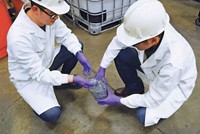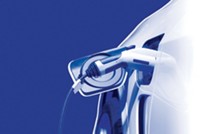Advertisement
Grab your lab coat. Let's get started
Welcome!
Welcome!
Create an account below to get 6 C&EN articles per month, receive newsletters and more - all free.
It seems this is your first time logging in online. Please enter the following information to continue.
As an ACS member you automatically get access to this site. All we need is few more details to create your reading experience.
Not you? Sign in with a different account.
Not you? Sign in with a different account.
ERROR 1
ERROR 1
ERROR 2
ERROR 2
ERROR 2
ERROR 2
ERROR 2
Password and Confirm password must match.
If you have an ACS member number, please enter it here so we can link this account to your membership. (optional)
ERROR 2
ACS values your privacy. By submitting your information, you are gaining access to C&EN and subscribing to our weekly newsletter. We use the information you provide to make your reading experience better, and we will never sell your data to third party members.
Materials
How many chemical elements does it take to build a car?
Detailed inventory shows that electric vehicles are more vulnerable to material supply challenges than gas guzzlers
by Mark Peplow, special to C&EN
July 16, 2021

A pinch of arsenic, a dash of krypton, a soupçon of tantalum, and a whole load of copper—these are just some of the 76 chemical elements that go into making modern automobiles, according to an exhaustive analysis of the materials found in a range of cars (Environ. Sci. Technol. 2021, DOI: 10.1021/acs.est.1c00970).
The work is no mere bookkeeping exercise. It reveals how the trend towards electric vehicles is changing the recipe for automobiles and exposing automakers to potential vulnerabilities in the supply chains of these ingredients. Because supply disruptions could translate into higher prices that hamper the adoption of electric vehicles, automakers and policymakers need to know where those pinch points are and avoid them, says Randolph E. Kirchain, a materials systems scientist at the Massachusetts Institute of Technology, who led the research.
Kirchain’s team gathered data on seven sedans and SUVs produced in 2019-20 by the Ford Motor Company, including internal combustion engine vehicles and plug-in hybrids that partly rely on batteries. The researchers used the International Materials Data System, widely used by automakers and their suppliers, to calculate the mass of more than 2,000 different materials found in the vehicles’ components. Then they delved into the CAS registry (a division of the American Chemical Society, which publishes C&EN) to find the elemental composition of each compound (except mica, natural rubber, and graphite, which all face supply risks but contain unremarkable elements). These records accounted for about 84% of the mass of the vehicles, so the researchers developed a machine-learning algorithm to help identify the materials in that missing mass, based on comparisons with similar components.
The seven vehicles contained a total of 76 elements present in quantities of at least 1 mg, with each model containing 67–70 elements. And in case you wondered, arsenic is found in the vehicles’ lead-acid battery, krypton in the headlights, and tantalum in capacitors.
The information in this paper “really permits studies on criticality and sustainability to have a lot more nuance,” says Thomas E. Graedel, a chemical engineer at Yale University who studies the flow of materials in industry and was not involved in the research.
The researchers also estimated automakers’ vulnerability to disruptions in the supply of each element, by calculating how shortages might increase the costs of materials. The researchers worked out this dollar value—called exposure—by combining information about the mass of each element in a vehicle, its average price per gram between 1998 and 2015, and its price volatility during that time. “A lot of people like to talk about there being exposure to certain materials in a qualitative sense, but we wanted to come up with a metric for it,” says graduate student Karan Bhuwalka, who is lead author of the study.
The upshot is that for an automaker producing 1 million vehicles per year, a complete transition from internal combustion vehicles to plug-in hybrids would hike their total exposure from $1 billion to $2 billion. “Qualitatively, people are aware of this issue,” Kirchain says. “But there’s a lot of power in that number to motivate investment in developing substitutes or finding ways to use less material.”
Almost half of this additional exposure is found in the batteries in hybrid cars, which rely on elements such as cobalt and nickel. But copper also poses a significant risk, because of its price volatility and the large amounts needed for wiring. And for all modern vehicles, regardless of their power source, the extensive use of gold in sensors and other electronic systems brings a growing exposure risk. “There are also going to be elements that we don’t need any more” in electric vehicles, Graedel adds—for example, platinum-group metals found in catalytic converters.
Kirchain says that policymakers and automakers should invest in research to reduce the use of critical materials, find substitutes, and build capacity to recycle more vehicle components at the end of their life. Indeed, the high cost of supply disruptions demonstrates that recycling should not be viewed as a virtuous but expensive chore—rather, it serves as a financial hedge against price increases of scarce virgin materials.





Join the conversation
Contact the reporter
Submit a Letter to the Editor for publication
Engage with us on Twitter